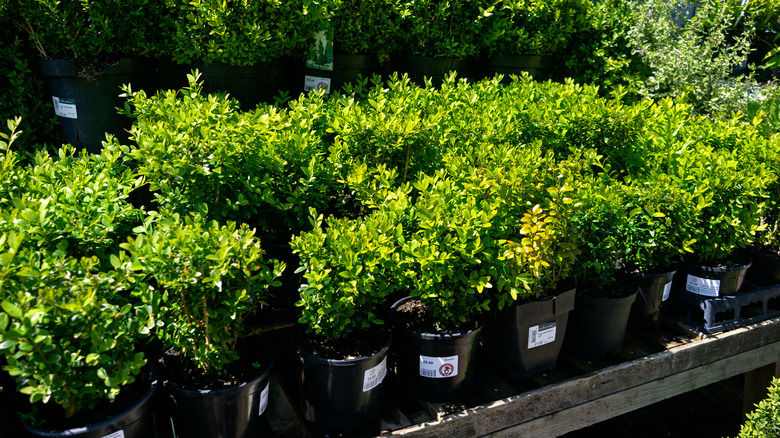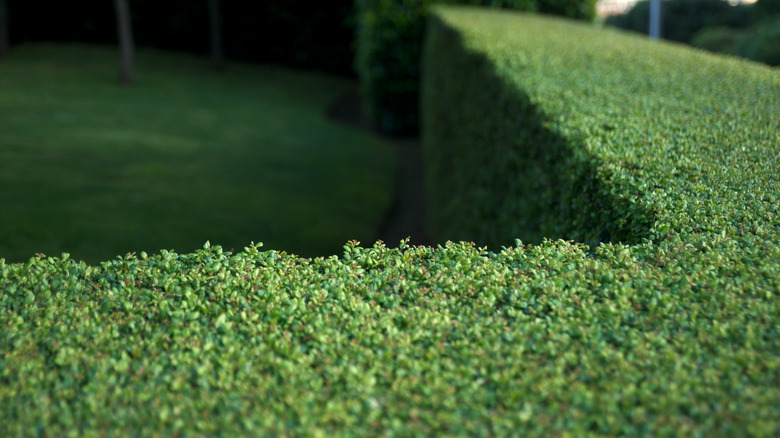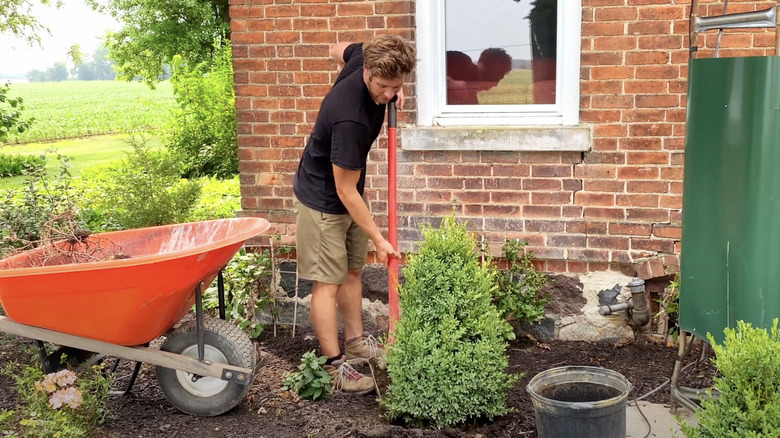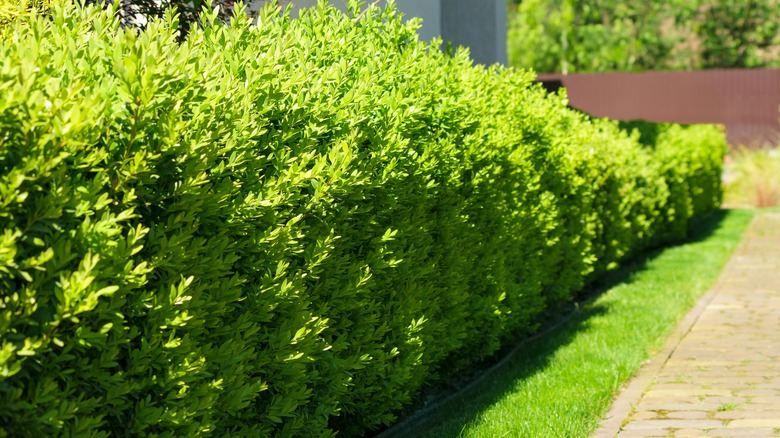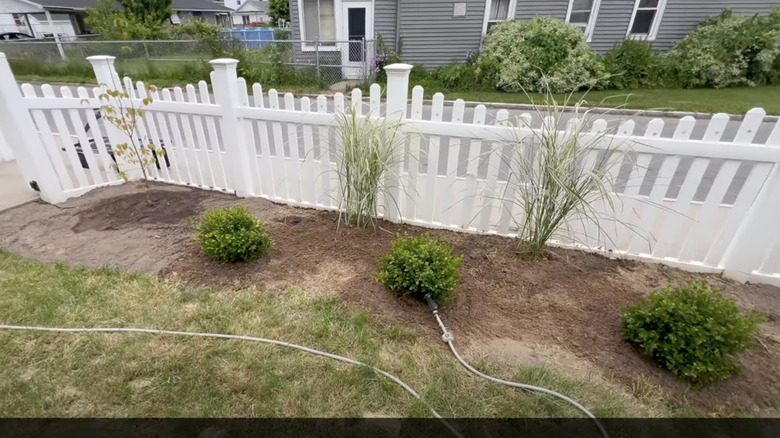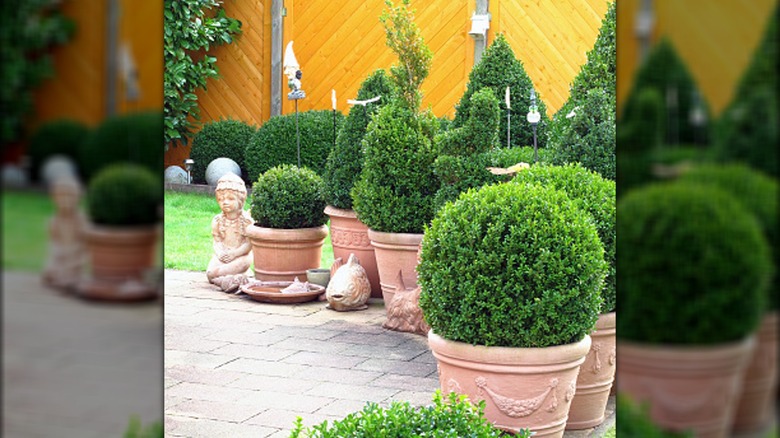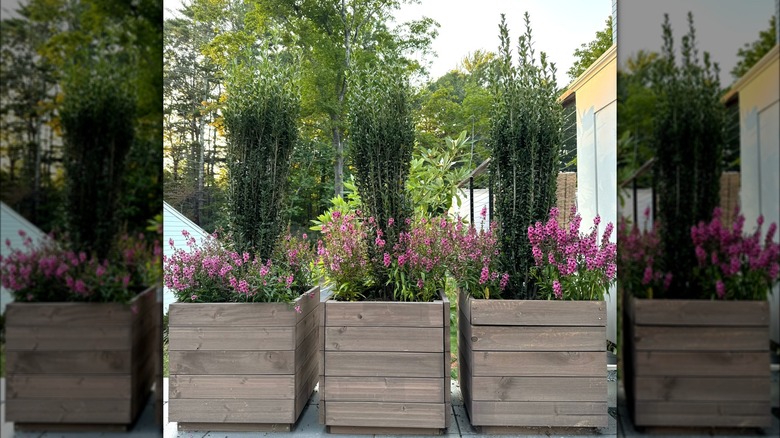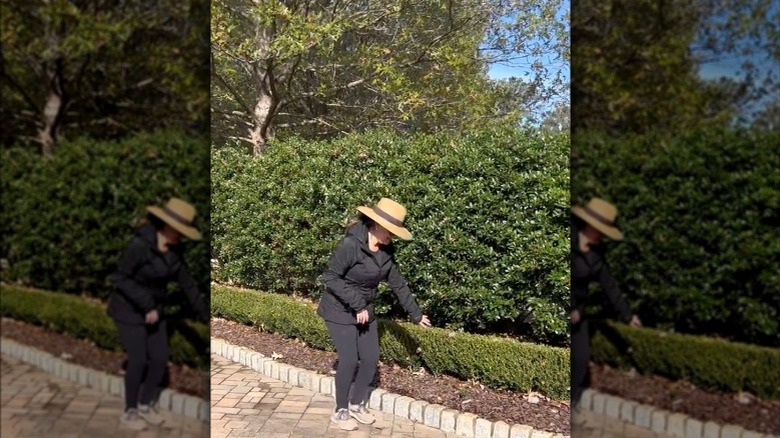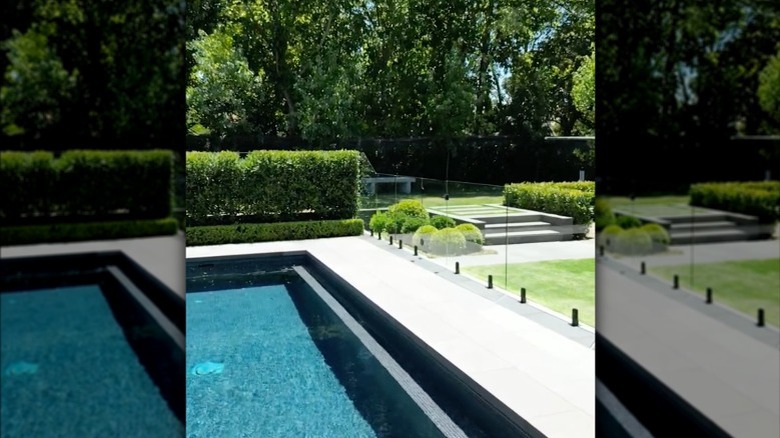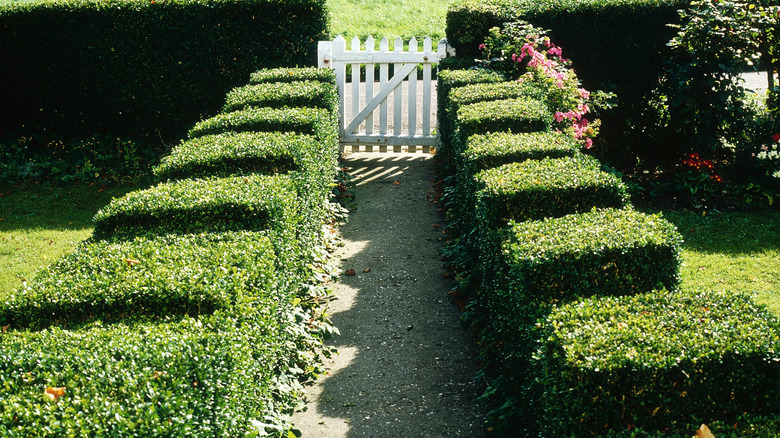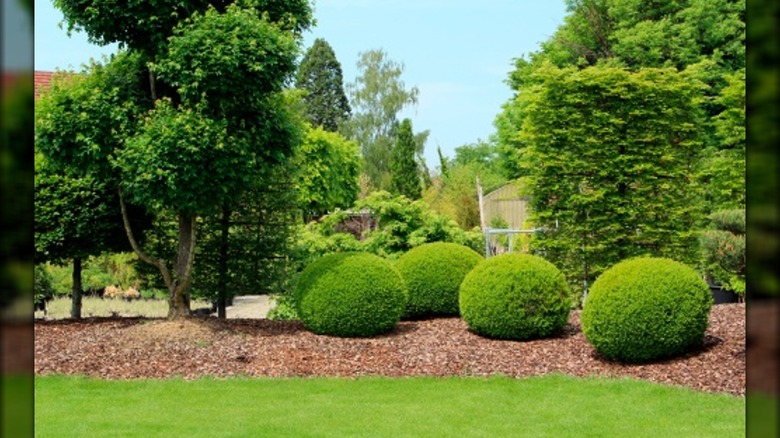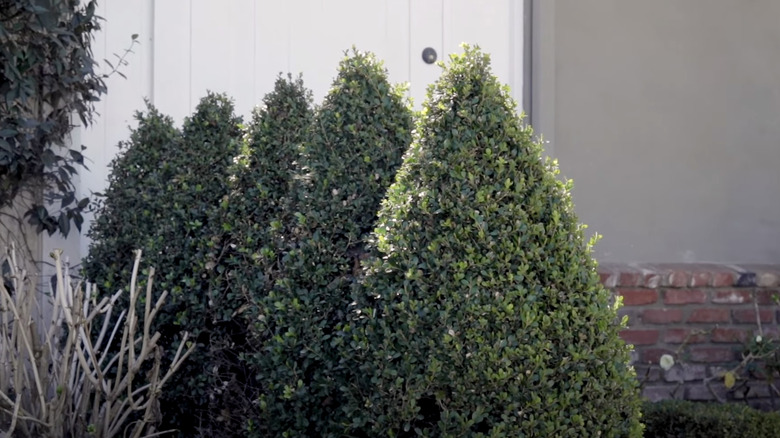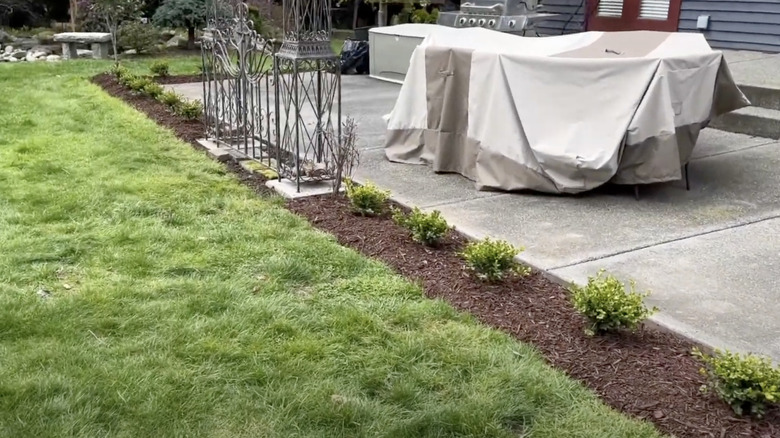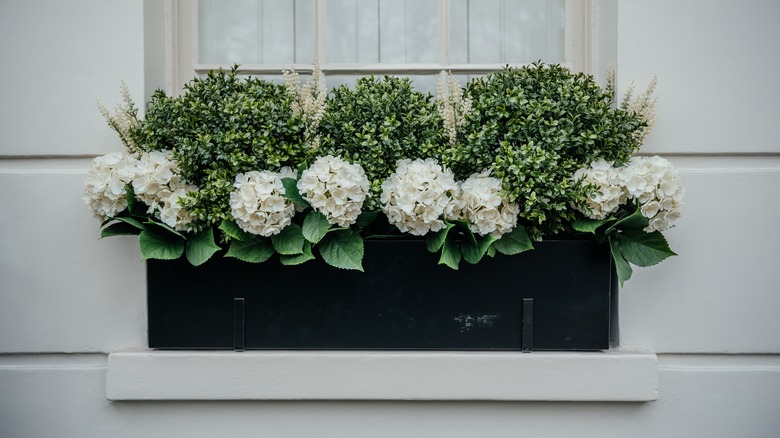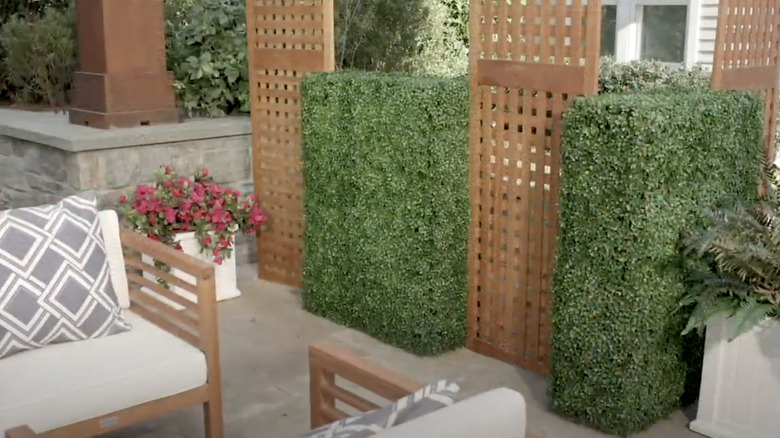14 Landscaping Ideas For Using Boxwood Plants For Backyard Privacy
Creating a backyard you can relax in, free from prying eyes of neighbors or passersby, comes down to choosing the right features. Sure, you could build a great big wooden fence and be done with it — and that might be perfect for the more utilitarian gardener. Others, however, take a softer approach to privacy, using plants to sculpt areas of seclusion. Boxwoods might not spring to mind when you think of a living privacy wall. You might instead think of those carefully sculpted, puffy green balls dotting entranceways and driveway borders. But actually, there are many ways you can use this popular evergreen shrub that's perfect for plant sculpting to create the solitude you crave.
Boxwood (Buxus species) has tons of benefits for home gardeners seeking seclusion. For one, it stays green all winter in many (though not all) parts of the United States. It's also highly deer resistant, and cultivars encompass a wide range of sizes and growth habits, making the plant really flexible. They really only require a well-drained plot and fertilizer once a year in the spring.
Keep it classic with a formal boxwood hedge or fence
The traditional way of using boxwoods for privacy is by planting them in neat rows. As they grow, they meld together, forming a hedge. Formal boxwood privacy plantings such as hedges and fence rows require lots of maintenance to keep the lines of the shrubs neat and crisp. A boxwood is essentially a small tree, and pretty much all trees tend toward wildness if left to their own devices. For centuries, humans have overcome this in hedge plants with regular and vigorous pruning.
Plant a boxwood right in front of an exposed window
If your windows face neighboring backyards, you probably feel a bit exposed. The solution is to either keep your curtains closed, or plant boxwood in front of them. Best of all, evergreen boxwoods offer year-round window coverage; they won't leave you exposed to prying eyes come fall. Choose a medium-sized tree — like a Korean boxwood (Buxus sinica), which grows about 10 feet tall — that will grow tall enough to cover at least half of your window, offering you the privacy you seek without compromising natural light.
Let your boxwoods grow wild and tall
Some boxwood cultivars reach 20 feet tall if left to their own devices — here's looking at you, common boxwood (Buxus sempervirens) and you, English boxwood (Buxus sempervirens 'Suffruticosa'). Planting them in a row along your fence line and letting them thrive means you'll have a towering stand of scrubby shrubs in no time. That'll block any nosy neighbors' line of sight into your backyard for sure! You'll still need to tame your overgrown shrubs occasionally for their health and your safety, but sculpting-level pruning skills won't be necessary.
Plant boxwoods with grasses along a fence line to boldly cover gaps
If you have a particularly exposed front yard, planting dense boxwoods together with tall native grasses along your fence line provides that perfect balance of privacy and drama. The contrast between the long, sleek, blue-gray hued grasses and the bright, bubbly green boxwoods is eye-catching and bold; the solid boxwoods are a jolt of structure within the free-flowing grasses. Plus, let's face it, boxwood shrubs could do with a bit of modernization. And what's more contemporary than the grasses used in modern American gardens?
Grow boxwoods in planters for flexible patio privacy
Boxwood shrubs take well to container life. To transform them into a privacy fence, plant multiple boxwoods in tall, wide planters and arrange them along the border of your patio or deck. By using over-sized pots, you'll have an instant privacy fence even before the plants reach maturity. Alternatively, plant the containers with mature transplants rather than saplings to bypass the gangly teenager stage entirely. This idea is perfect for renters since you can easily pack up your boxwood pots and set them up in your next dwelling.
Raised beds combined with mature boxwoods add instant height
Planting boxwoods in raised beds performs a similar function to the aforementioned boxwoods-in-planters privacy solution, but the added height a raised garden bed provides means you can use more diminutive varieties of boxwood. Plus, you don't have to wait so long for them to grow large enough to provide that much-needed seclusion. You can make raised beds from all kinds of materials: timber, stone, bricks, pavers, poured concrete ... You're really only limited by your imagination and what you have on hand.
Patch gaps in tall privacy hedges with a smaller boxwood hedge
Even the most compact and well-kept tall hedges end up with gaps, reducing the privacy they once provided. If you hate the look of exposed tree legs and catching glimpses of your neighbor's backyard, plant short boxwoods to create a mini hedge. With regular printing to keep it neat, it will disguise the space between the ground and the start of the foliage of the boxwood shrubs' taller cousins. The Harland boxwood (Buxus harlandii), which grows to about 3 feet tall, is an ideal cultivar to fill that space.
Grow boxwoods to hide an ugly swimming pool safety fence
Swimming pool safety fences are notoriously ugly. That's neither here nor there, really, since they fundamentally serve a protective function. However, being a responsible pool owner doesn't mean sacrificing good looks or an appealing outdoor aesthetic. Planting a boxwood hedge along the fence achieves two purposes: it disguises the existing fence and offers privacy for swimmers or poolside loungers. Just double check with your local municipality on the rules around pool fences. Many have specific requirements you need to adhere to that may ban shrubbery near the fence.
Direct people to your front gate using a boxwood hedge
If you want to ensure people enter your property where you want them to without getting a peek inside your yard first, plant a boxwood hedge along the perimeter of your fence line until each side meets your gate. From there, you can create a path that leads to your front door, back door, or wherever you wish to direct visitors. You can also prune the two boxwoods closest to the gate into sculptural balls or other shapes to further accentuate the entryway.
Grow boxwoods on berms in strategic places on your property
A berm garden adds height to an ordinarily flat backyard. Berms don't have to be long or right next to each other, either. You can place them strategically around the yard so they overlap, visually disrupting the direct line of sight to your property and creating privacy without the hard lines of fences or hedges. Plant the berms with dense boxwoods (and other shrubs and plants if you wish) and you'll have all the seclusion you want. Just note that berms require lots of topsoil that you'll have to source.
Bundle boxwood topiaries together
It's fair to say that most people have seen boxwood shrubs shaped into squat balls or tall cones. These topiary shapes are common, and even a little boring; there's a range of other options, from spirals to all kinds of animals. You're really only limited to your creativity and your ability to channel the skills of Edward Scissorhands when it comes to what you create. Of course, if you're aiming to create a privacy screen for a patio, it would be smart to choose dense shapes that you're able to bundle together without any gaps.
Boxwood patio privacy screen for a garden room
If you think of your patio as a garden room, building walls to enclose it makes sense. Of course, you're outdoors, so solid walls will keep out too much of that beautiful nature you're looking to enjoy in the first place. Instead, plant a hedge of boxwood shrubs to wall in your alfresco living area and create a sense of privacy and definition without closing the entire space off to that much-needed evening summer breeze or dappled winter sunlight. Taller, wider varieties of boxwood work best, like green mountain boxwood (Buxus x 'Green Mountain').
Plant boxwoods in a window box for focused privacy
Planting boxwood in a window box just makes sense. The plants stay green all year, so if you're looking to provide a room of your house with a little privacy sans curtains or blinds, this is a smart, simple, and affordable solution. If you already have window boxes, plant them as you would a planter or small raised bed. If you need to build something, HGTV's stunning DIY window box is affordable and totally genius. Choose miniature or dwarf boxwood cultivars, like 'Little Missy' dwarf boxwood (Buxus microphylla 'Little Missy').
Go faux with easy-mount boxwood hedge panels
We'd be remiss if we didn't include faux boxwood hedges. We're here for all of you green thumb-less readers! There's nothing wrong with going artificial for quick patio privacy. The panels or tiles feature bright green shrubbery attached to a plastic mesh backing, making them very easy to mount on the wall or, in the case of creating privacy, a fence. Walmart, for example, sells a 12-pack of 20 x 20 inch boxwood hedge wall panels for just under $60. Replace the tiles with real plants later if you have the inclination.
